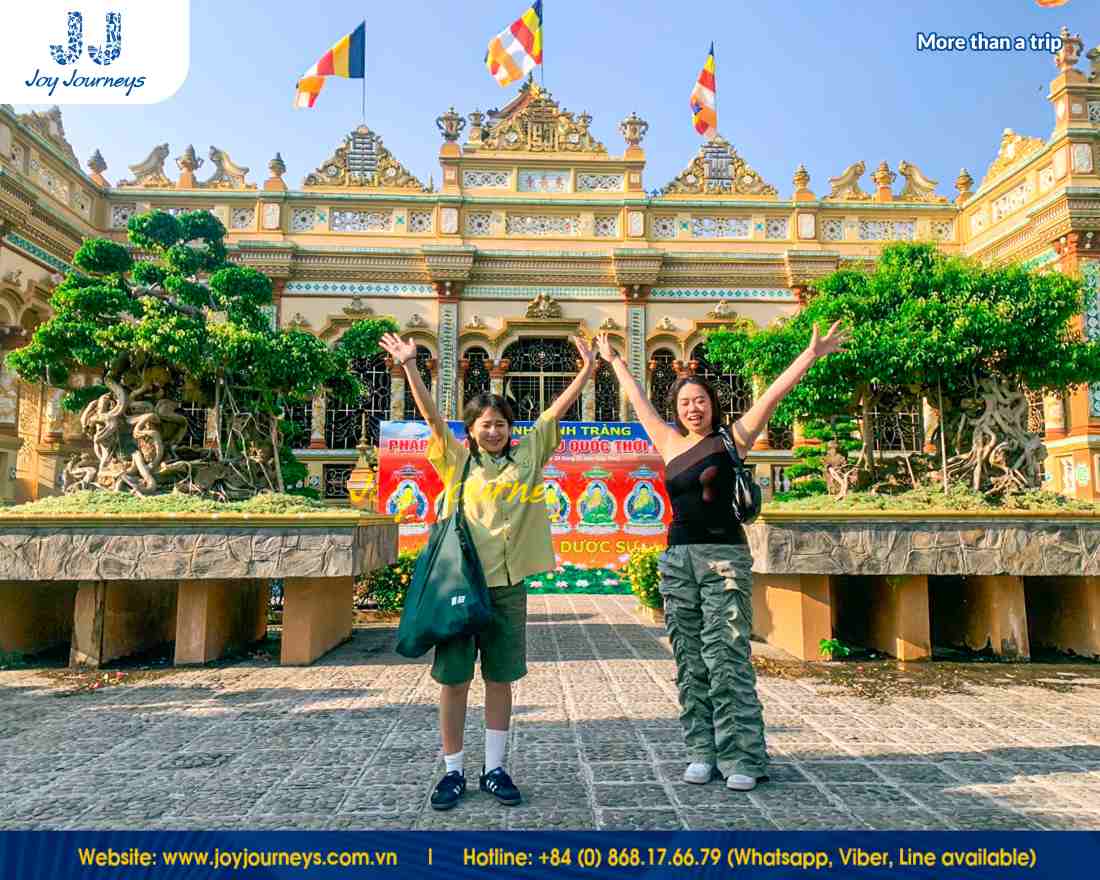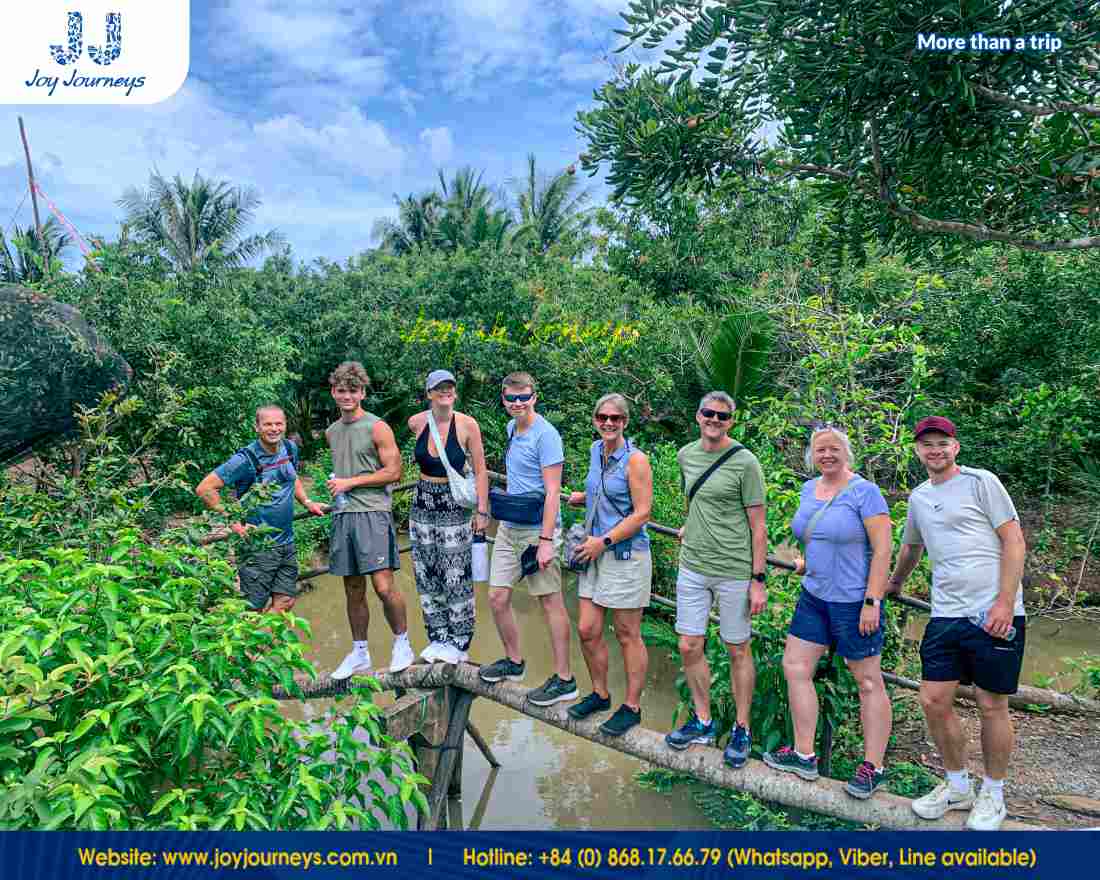A tapestry of emerald waterways and fertile plains, the Mekong River Delta unfolds like a Vietnamese wonderland. This strategic hub, blessed with a tropical monsoon climate, is a prime destination for agriculture and tourism. As you embark on your Vietnamese adventure, exploring the Mekong Delta is a must.
To fully appreciate this enchanting region, let’s delve into its history, understand its climate, and discover how Joy Journeys can help you plan an unforgettable trip.
Contents
The rich history of Mekong Delta Vietnam
Today, the Mekong Delta spans approximately 40,000 km2, covering almost the entire area of 13 provinces and cities in the Southwest region.
Geographical location
The Mekong Delta, also known as the Southwest area, has a total area of 40,577.6 km² and a population of 17,744,947 people (as of 2022). It is the southernmost part of Vietnam, located southeast of Cambodia. It is the most fertile land and the most populous region in the country.
Rice is the backbone of the Delta’s economy. It occupies a significant portion of the land, accounting for 54% of its total area and 58% of Vietnam’s national rice output. Additionally, the region’s rice exports contribute substantially to the country’s economy, representing 93% of the total rice exports.

Beyond that, the Mekong Delta is a significant hub for seafood production. About 77% of its area is reserved for fishing and aquaculture which contributes 40% of the country’s seafood output and 60% of its exports.
Historical timeline of development
The history of Mekong Delta Vietnam developed in the 17th century when the Nguyen lords organized the initial administrative units on this land. They gradually expanded until the middle of the 18th century, when they completely controlled the entire Delta.
The division and administrative arrangement changed a lot over the centuries. This land was first mentioned in Chinese academic works as part of “the ancient kingdom of Funan.” The Funan civilization was influenced by Hindu and Buddhist culture and developed strongly from the middle of the 1st and 5th centuries AD.
The Cham and Khmer people settled in this land in the 7th century, and the Khmer civilization began to penetrate strongly in the 9th and 10th centuries. Some Vietnamese people lived under Khmer rule, but with the defeat of the Cham at the end of the 15th century, they gradually migrated to the South.
In the 17th century, many Chinese people fleeing the northern dictatorship moved to the South. The Tay Son Rebellion in the late 18th century also contributed to the settlement of more families in this promised land. This is why the fertile southwest land today blends three cultures: Chinese, Vietnamese, and Khmer.

The French colonial invasion quickly ended the civil strife in this area. They prioritized the Vietnamese and Chinese for continued settlement, as they could better promote trade compared to the Khmer. As more Vietnamese moved to the South, more Khmer left.
During the Japanese occupation in the 1940s, many people fled from the north to the southern region to escape the fighting. However, the war eventually spread to the Mekong Delta and the refugees were forced to reclaim previously uninhabited mangrove swamps to make a living. This is why the Southwest region is what it is today.
Outstanding cultural features
Today, the Mekong Delta still preserves the uniqueness of many different cultures because the population mainly includes 4 ethnic groups: Kinh, Khmer, Hoa, and Cham.
- Nearly 2 million Khmer people live near Soc Trang city and the Cambodian border. A small number of Cham people also live near the Cambodian border. However, unlike their compatriots in the central highlands, these Cham people are not Hindus but Muslims.
- The region’s cultural diversity makes it home to many different religions, including Buddhism, Catholicism, Caodaism, and Islam. Tourists visiting the Southwest will have the opportunity to explore the cultural diversity and experience the hospitality of the people here.

Mekong Delta weather by month
To choose the best time to visit the Mekong Delta, consider the activities you want to experience, as the weather in the Mekong Delta changes throughout the year.
Tropical monsoon climate
This region has Vietnam’s typical climate, which is a tropical monsoon. However, the weather is hot all year round because it is close to the Equator and not affected by the Northeast monsoon.
Two distinct seasons
- Dry Season (December-April): The Mekong Delta dry season is long, but the rainy season is uneven across the region. As a result, some provinces may experience drought. The weather in March-April is quite hot and dry, so bring bottled water to quench your thirst during this season.
- Rainy Season (May-November): The rainy season in the Southwest has heavy rains with short duration. From September to November, there are more heavy rains that last a long duration. This sometimes leads to flash floods.
Average temperatures and rainfall
- The Mekong Delta has a high, unchanging temperature throughout the year, mainly in the range of 25°C – 27°C, with 2,200 – 2,400 hours of sunshine annually. Mekong Delta weather by month has clear differences, but the hottest time is March and April, with daytime temperatures of 28°C – 35°C.
- From May to November, it receives a fairly large amount of rainfall, about 1300 – 2000mm annually. Heavy rains across the basin from August to December often cause flooding in the area, with about 50% of the area inundated. On the other hand, in the dry season, there is often a shortage of rain, especially in areas affected by saltwater intrusion.
Best time to visit Mekong Delta
Peak season (October-February):
The peak season brings cooler temperatures and a vibrant atmosphere, perfect for exploring the Delta’s festivals and cultural events. While the region may experience occasional flooding during this time, it’s a minor inconvenience compared to the wealth of natural beauty and cultural experiences.

Shoulder seasons (March-May & September-October)
These shoulder seasons offer a delightful blend of pleasant weather and fewer crowds. The landscape is adorned with blooming trees and lush greenery, forming a picturesque setting for your exploration.
Low season (June-August)
Although the low season is characterized by heavier rainfall and the potential for flash floods, the Mekong Delta remains a captivating destination. The high water levels contribute to the region’s unique charm, with lush greenery and vibrant waterways dominating the landscape.
FAQs about Mekong Delta tourism
Is it worth going to Mekong Delta?
Yes, it is definitely worth exploring! With its nature reserves, ancient traditions and tropical islands, the Mekong Delta offers so much to see and do that you could spend weeks traveling around it.
How to get to Mekong Delta from Ho Chi Minh City?
- Buses: Express and sleeper buses offer comfortable journeys to the Mekong Delta. It usually takes more than three hours. You can purchase tickets directly at the Western bus station or conveniently book online.
- Motorbikes: For those seeking a more adventurous experience, renting a motorbike will offer a greater flexibility.
- Speedboats: Speedboats provide a thrilling way to navigate the Mekong River, offering stunning views of the surrounding landscape.
What do many tourists go to the Mekong River Delta for?
The Mekong Delta is renowned for its:
- Breathtaking Scenery: Lush forests and tranquil rice paddies create a picturesque backdrop for your exploration.
- Cultural Immersion: Visit traditional villages, experience the vibrant floating markets, and savor delicious local cuisine at affordable prices.
How to explore the Mekong Delta?
- Backpacking: Independent travelers can purchase bus tickets to any provinces in the Mekong Delta. You can also use public transportation, or rent a motorbike to explore this region.
- Tour travel: You can consider taking a tour for a tourism company such as Joy Journeys. Our tours focus on authentic experiences and cultural immersion. The consultants can also tailor private tours to meet your specific needs.
Conclusion
The Mekong Delta offers a glimpse into Vietnam’s diverse cultures. From the expansive rice fields and lush fruit gardens to the vibrant floating markets and lively festivals, the region showcases the harmonious coexistence of over 40 ethnic groups.
Contact us if you want to craft a “more than a trip” journey in the Mekong River Delta:
- Website: joyjourneys.com.vn
- WhatsApp: +84 (0) 868.17.66.79


Related Posts
Saigon’s “Flower Market Replica”: Where To Find Them
Ho Chi Minh City’s floral charm is not limited to its bustling wholesale markets. Imagine wandering through a place where vibrant petals, fragrant blooms, and the spirit of traditional Vietnamese markets come alive—without the overwhelming crowds. A flower market replica captures that magic, blending the beauty of fresh flowers with the charm of a curated, […]
Is it Safe to Travel to Vietnam Right Now? A Complete 2025 Guide
Vietnam has emerged as one of Southeast Asia’s most captivating destinations, drawing millions of visitors annually with its rich culture, stunning landscapes, and incredible cuisine. However, many travelers still ask: Is it safe to travel to Vietnam right now? This comprehensive guide provides you with everything you need to know about Vietnam travel safety in […]
Ho Chi Minh Cu Chi Tunnels Tour: The Ultimate Guide
The Cu Chi Tunnels stand as one of Vietnam’s most remarkable historical sites, offering visitors a profound glimpse into the ingenuity and resilience displayed during the Vietnam War. For travelers, a Ho Chi Minh Cu Chi tunnels tour represents an essential experience that combines education, adventure, and deep cultural understanding. This comprehensive guide will help […]